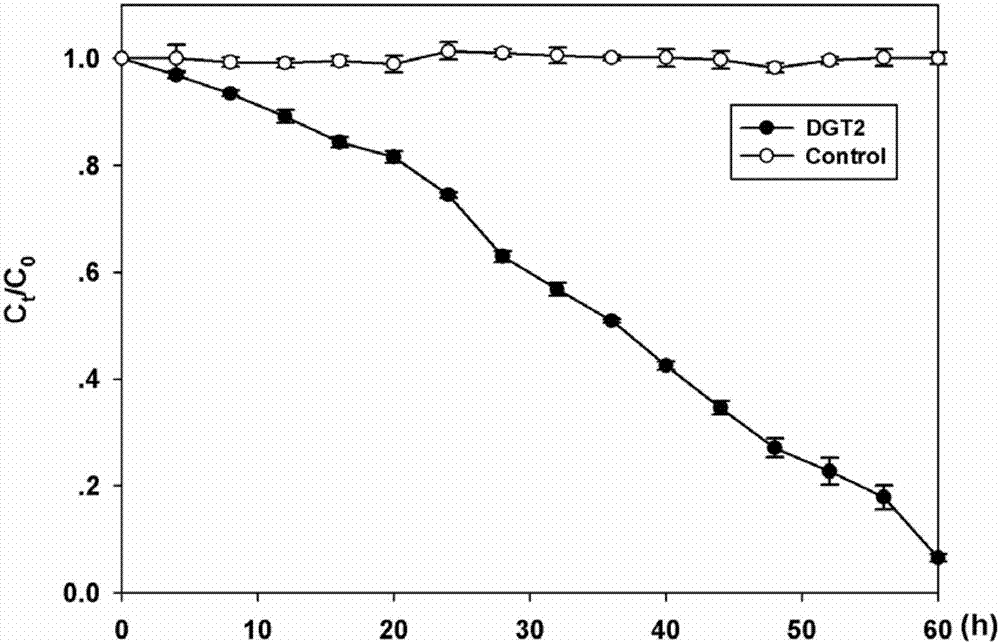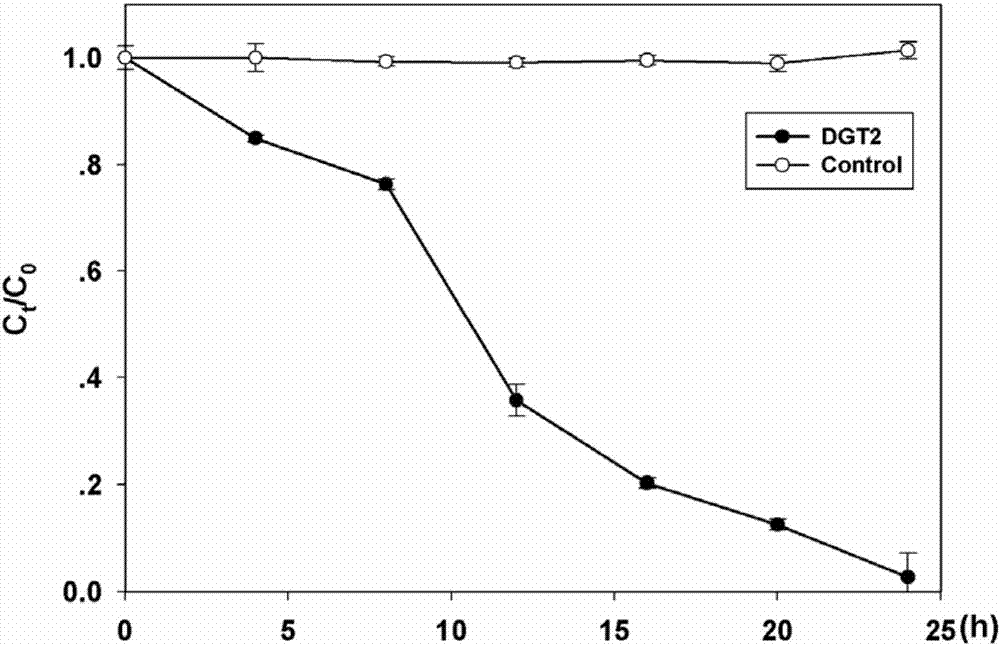Dydrogesterone degrading bacterium and application thereof
A technology of dehydroprogesterone and degrading bacteria, applied in bacteria, water/sludge/sewage treatment, biochemical equipment and methods, etc., to achieve the effect of fast degradation rate
- Summary
- Abstract
- Description
- Claims
- Application Information
AI Technical Summary
Problems solved by technology
Method used
Image
Examples
Embodiment 1
[0020] Example 1: Domestication, isolation and identification of dehydroprogesterone-degrading bacteria DGT2
[0021] The source of bacteria was collected from the flushing water of a large-scale pig farm in Foshan City, Guangdong Province. Collect sufficient flushing water, mix it and divide it into three 1L Erlenmeyer flasks, 500mL each; add dehydroprogesterone standard samples to make the concentration of dehydroprogesterone in the wastewater reach 500μg / L; seal with multi-layer gauze Then acclimatize and cultivate at 25°C and 150rpm in the dark; about 1 week later, add a higher concentration of dehydroprogesterone; repeat this method for acclimation several times, until 60 days, the concentration of dehydroprogesterone is 5mg / L.
[0022] After the acclimation is stopped, take 100 μL of the acclimatization solution on the MH agar medium, and spread the plate with the triangle coating method; after the plate is coated several times, select bacteria with different shapes, col...
Embodiment 2
[0025] Example 2: Degradation of high concentration dehydroprogesterone by bacterial strain DGT2 in MH broth medium
[0026] Prepare MH broth medium, sterilize and cool to room temperature, subpackage into 1L Erlenmeyer flasks under aseptic conditions, add dehydroprogesterone to make the initial concentration reach 5mg / L, the experiment is divided into two groups: (1) In the bacteria experimental group, the bacterial strain DGT2 was inoculated into the MH broth medium, and mixed evenly; (2) in the sterile control group, the DGT2 strain was not inoculated, and sodium azide (final concentration of 0.5% was added to the broth medium) ). All Erlenmeyer flasks were sealed with multi-layered gauze, wrapped in tin foil to avoid light, and placed in a shaker (150rpm, 25°C) for cultivation; the experimental group and the control group were set in three parallels, and the concentration of dehydroprogesterone in the culture medium was continuously measured. Residue, analyze strain DGT2 ...
Embodiment 3
[0028] Example 3: Degradation of high-concentration dehydroprogesterone by bacterial strain DGT2 in pig wastewater
[0029]The wastewater was collected from the flushing water of a large-scale pig farm in Foshan City, Guangdong Province. The sterilized wastewater was divided into conical flasks under aseptic conditions, and dehydroprogesterone standard samples were added to make the dehydroprogesterone concentration in the wastewater reach 5 mg / L. The experiment was divided into two groups: (1) the bacteria experimental group, the strain DGT2 was inoculated into the sterilized pig raising wastewater, and mixed evenly; (2) the sterile control group, the DGT2 strain was not inoculated, and azide was added to the wastewater NaCl (0.5% final concentration). All Erlenmeyer flasks were sealed with multi-layer gauze, wrapped in tin foil to avoid light, and placed in a shaker (150rpm, 25°C) for cultivation; the experimental group and the control group were set up in 3 parallels, and ...
PUM
 Login to view more
Login to view more Abstract
Description
Claims
Application Information
 Login to view more
Login to view more - R&D Engineer
- R&D Manager
- IP Professional
- Industry Leading Data Capabilities
- Powerful AI technology
- Patent DNA Extraction
Browse by: Latest US Patents, China's latest patents, Technical Efficacy Thesaurus, Application Domain, Technology Topic.
© 2024 PatSnap. All rights reserved.Legal|Privacy policy|Modern Slavery Act Transparency Statement|Sitemap



